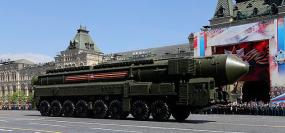
Influence of the Defense Industry on US National Security Strategy
This article is part of a series on the impact of U.S. and Russian military complexes on the bilateral relationship. "Russia’s Defense Industry and Its Influence on Policy: Stuck in a Redistributive Feedback Loop" by Pavel Luzin can be found here.
As the Soviet Union collapsed, so too did the Pentagon’s procurement budget, which shrank by more than two-thirds between 1985 and 1997. With the loss of its primary strategic competitor, the U.S. government no longer needed as many weapons, and the U.S. defense industry lost much of its raison d’être. However, somewhat counterintuitively, the influence of the U.S. defense sector on U.S. national security and foreign policy, as well as over the Pentagon’s procurement decisions, was dramatically strengthened after the end of the Cold War. This growth in influence was directly fostered and facilitated by the U.S. government itself, which ultimately created a corporate juggernaut that exercises inordinate influence over U.S. government policy today, particularly vis-à-vis Russia.
After the Cold War, the Pentagon concluded that the U.S. defense industry was too bloated to thrive in a new reality, with room for only a handful of companies to supply the nation’s weapons. This prompted what is now colloquially known as the “Last Supper”––an infamous 1993 dinner hosted by then-Deputy Secretary of Defense William Perry for the chief executives of the top weapons contractors––during which Perry encouraged rapid consolidation in order to stabilize the market. Perry’s warning triggered a feeding frenzy of mergers and acquisitions, during which more than 50 discrete Pentagon suppliers consolidated into just five mega-companies. At the time, The Washington Post suggested that, by “the end of his second term, it may emerge that President [Bill] Clinton's most enduring legacy in national security will be his role in creating a handful of extraordinarily powerful defense contractors.”
Today, these types of mega-companies exercise a tremendous amount of influence over U.S. national security and foreign policy, as well as over the Pentagon’s procurement decisions. This influence is exercised in myriad ways, including lobbying, earmarking––a congressional practice used to direct funding toward specific, often unnecessary, preferential military projects––and contributing to the election campaigns of congressional candidates. Since 1990, the defense sector has contributed nearly $350 million to such campaigns,1 has spent approximately $110 million on lobbying every year since 1998 and has typically employed between 500 and 1,200 registered lobbyists each year.
Notably, over the past decade approximately three-quarters of these defense lobbyists came through the “revolving door,” meaning that they alternately occupied regulatory or oversight positions in government and corporate positions in the private sector. One particularly egregious case involving “senator-turned-lobbyist-turned-senator-turned-lobbyist” Jon Kyl is emblematic of how the revolving door enables clear conflicts of interest with regards to defense spending. During his brief four-month stint in the Senate in 2018, Kyl advocated and voted in favor of legislation that would increase the profits of several defense companies that had previously employed him as a lobbyist or as a paid board member.
In particular, Kyl was a staunch advocate for the W76-2 “low-yield” nuclear warhead and voted in favor of its development. However, at the time, Kyl failed to disclose that up until he joined the Senate he had been a paid board member of National Technology & Engineering Solutions of Sandia, which operates the same national laboratory that would end up developing the new W76-2 warheads. Kyl also did not disclose at the time that he owned up to $15,000 worth of corporate securities stock in Honeywell, Sandia’s parent company. Immediately following the completion of his Senate term, Kyl returned to his previous lobbying firm in an “advisory” capacity, a common practice that watchdogs call an obvious loophole.
This example demonstrates how the cozy financial relationship between U.S. lawmakers, the defense industry and the Pentagon has fostered a system that generally rewards ever-increasing––and often redundant––military investment, particularly via-à-vis Russia. The low-yield W76-2 warhead––in addition to the Trump administration’s proposed nuclear sea-launched cruise missile––were both heavily supported by the U.S. defense industry, and the Trump administration’s Nuclear Posture Review (NPR) specifically claimed that these supplemental capabilities were necessary in order to deter Russia’s alleged plans for “limited nuclear escalation.” However, the NPR provided no evidence to suggest that existing U.S. capabilities would be insufficient to deter Russia, or that the yield of U.S. nuclear weapons would be a factor in whether Russia would decide to use nuclear weapons in a crisis. Additionally, the actual existence of Russia’s supposed “escalate-to-deescalate” doctrine is highly contested, yet the weapons that are specifically intended to counter it are now either deployed or in development.
In addition to the revolving door and other forms of lobbying, a recent Sludge investigation revealed that at least 47 members of Congress and their spouses own between $2 million and $6.7 million worth of stocks in companies that rank among the top 30 global defense contractors. Much of this influence is concentrated among the members of the influential armed services committees and defense appropriations committees in both the House of Representatives and the Senate.
These obvious conflicts of interest are neither illegal nor prohibited, creating several challenges. First, the mere perception of foul play can cause the public to lose faith in their elected officials. This can create a trust vacuum where conspiracy theorists or cynical politicians can thrive. Second, selecting contractors based on their influence or, worse, considerations of self-interest––rather than on cost-effectiveness––often leads to significant budgetary waste. In 2011, the Project on Government Oversight found that “the federal government approves service contract billing rates—deemed fair and reasonable—that pay contractors 1.83 times more than the government pays federal employees in total compensation, and more than 2 times the total compensation paid in the private sector for comparable services.”
Third, and perhaps most worrisome, corporate influence sometimes trumps national strategy when it comes to military decisions. For a perfect example, look no further than the U.S. intercontinental ballistic missile force. Over the past 15 years, politicians that represent ICBM host states2 have played an outsized role in dictating U.S. nuclear force posture––occasionally even overriding the guidelines set by U.S. military leaders––in order to prevent any significant ICBM force reductions from taking place. During the congressional debate over New START force posture in 2013, representatives from ICBM host states helped quash an amendment that sought to reduce the number of ICBMs from 450 to 300, despite the fact that an inter-agency review––which included the participation of the State Department, the Defense Department, the National Security Council, the intelligence community, the Joint Chiefs of Staff, U.S. Strategic Command and then-Vice President Joe Biden’s office—had just concluded that U.S. deterrence requirements could be met by reducing U.S. nuclear forces by up to one-third.
More recently, during the contentious and ongoing debate about replacing the existing Minuteman III ICBM force with the brand-new $264 billion Ground-Based Strategic Deterrent (GBSD), defense corporations have played a major role in swaying the outcome in their favor. Northrop Grumman––selected in an unprecedented single-source bidding process to develop and build the new GBSD––employed 49 lobbyists in 2020, most of whom swung through the revolving door from previous positions in government. These lobbyists, in collaboration with the lobbying teams from other ICBM contractors like Lockheed Martin, helped quash an amendment to the 2019 National Defense Authorization Act calling for an independent study on a Minuteman III life-extension program. Numerous analysts––including the author of this article––have suggested that the Minuteman III force could be life-extended at a fraction of the GBSD’s price tag; however, the influence of the defense industry has helped ensure that this possibility could not be fully considered.
The congressional “ICBM Coalition” is generously funded by weapons contractors and other corporations that stand to materially benefit from continued investment in the ICBM program. A 2021 report by the Center for International Policy revealed that between 2012 and 2020 major ICBM contractors contributed approximately $1.2 million to the congressional campaigns of the coalition’s members, and over $15 million to members of the Senate and House armed services strategic forces subcommittees and the Senate and House defense appropriations subcommittees, which play a direct role in authorizing and appropriating funds for the ICBM force.
Congressional lawmakers benefit from their relationship with the defense industry for parochial reasons: ICBM bases in North Dakota, Wyoming and Montana are directly responsible for 8-13% of their respective labor forces, and indirect economic benefits––a commercial by-product of everyday activities like grocery shopping––inflate those percentages even further. For those reasons, politicians have historically jockeyed to bring missile bases to their states, and ICBM communities have formed coalitions via their Chambers of Commerce to advocate for their states’ bases to stay open. In turn, these local coalitions collaborate with the major ICBM contractors––which are very well-integrated with these communities––to drum up public support for nuclear modernization.
As part of this effort, the defense industry repeatedly claims that new weapons programs will create large numbers of jobs across the country. However, external analysis suggests that these claims are often exaggerated, and that defense investment is actually among the least productive of federal investment opportunities. The Costs of War Project at Brown University concludes that while $1 million in defense spending supports 6.9 jobs, the same amount directed toward clean energy and infrastructure supports 9.8 jobs, toward health care supports 14.3 jobs and toward education 15.2 jobs. Therefore, as their report summarizes, “for the same amount of spending, clean energy and infrastructure create 40% more jobs than the military, healthcare creates 100% more and education 120% more.”
National security and defense procurement policy should be the products of transparent and democratic processes, not shady business deals. The best way to fix this endemic problem is to draw clearer boundaries between the public officials who make policy and the defense companies who seek to influence that policy for material benefit. These boundaries could be strengthened relatively quickly by instituting several common-sense policies. For starters, members of Congress and senior government officials could be banned from trading individual stocks or serving on corporate boards while in office. In this vein, the Federal Reserve recently announced its intention to prohibit active trading and the purchasing of individual securities by its own employees, noting the clear conflicts of interest. Additionally, Members of Congress could be required to file their financial disclosures before taking office. Additionally, the revolving door could be slammed shut by permanently banning elected and appointed senior officials from serving as lobbyists and by lengthening the amount of time before a registered lobbyist can enter public office.
Policies like these would significantly reduce the overwhelming influence of the defense industry on national security and procurement policy. This would go a long way toward repairing public trust in U.S. institutions and politicians, eliminating fiscal waste and ensuring that military decisions were made on the basis of strategy––not business.
Footnotes
-
The defense sector contributes far less money to politicians than other influential sectors but is incredibly effective because it can target Congress members in the three committees in each house where all its interests are addressed—the Armed Services Committee, Foreign Affairs Committee and Appropriations Committee.
-
The “ICBM Coalition,” as it is known, consists of lawmakers from the three ICBM host states––Wyoming, Montana and North Dakota––plus Utah, where ICBM sustainment and replacement activities are headquartered at Hill Air Force Base. Occasionally, lawmakers from Louisiana––the home state of Air Force Global Strike Command––have also participated in the coalition’s activities.
Matt Korda
Matt Korda is a senior research associate and project manager for the Nuclear Information Project at the Federation of American Scientists and an associate researcher with the Nuclear Disarmament, Arms Control and Nonproliferation Program at the Stockholm International Peace Research Institute (SIPRI).
U.S. Navy photo by Photographers Mate 2nd Class Andrea Decanini shared in the public domain. The opinions expressed herein are solely those of the author.

